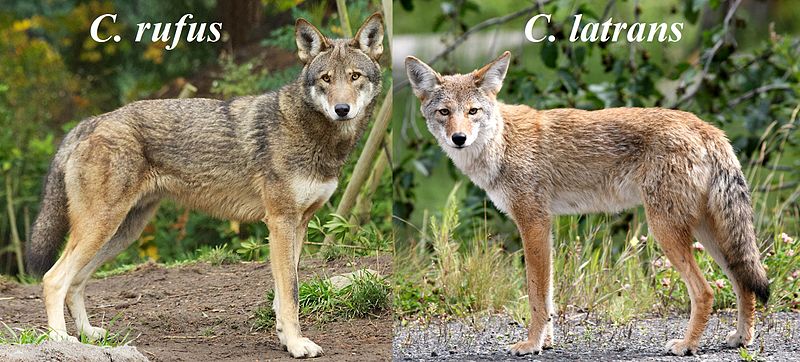| HOME > News > |
Thursday, May 15, 2014 10:13am


A side-by-side comparison of a red wolf (left) and a coyote (right).
United States District Judge Terrence Boyle recently granted an injunction to halt coyote hunting across 1.7 million acres of land in North Carolina’s coastal counties. According to The Charlotte Observer, Boyle made the decision to protect the estimated 100 red wolves living in the area, which can be mistaken for coyotes. The territory is believed to be the home of the last remaining wild population of red wolves in the world, and it also happens to host an increasing number of coyotes.
The affected area includes five North Carolina counties: Beaufort, Dare, Tyrell, Hyde, and Washington. The Associated Press reported that the injunction is meant to last until the start of a trial in a lawsuit by environmental groups to permanently end coyote hunting in the area.
“By authorizing coyote hunting in the five-county red wolf recovery area, and in particular by authorizing coyote hunting during all seasons and at any time day or night, the commission has increased the likelihood that a red wolf will be shot,” Boyle wrote in the ruling.
According to the North Carolina Wildlife Resources Commission, coyotes share similarities with red wolves, but are smaller, have pointed ears, and long slender snouts. Coyotes weigh on average 20 to 45 pounds while red wolves generally weigh 40 to 90 pounds. However, both animals stand about two feet tall at the shoulder and four feet in length. Unlike red wolves, coyotes are not native to the state. Wildlife officials believe that the animal expanded into North Carolina from Tennessee, Georgia, and South Carolina in the 1980s. Despite attempts to control the population, the animal has become firmly established in all of the state’s 100 counties.
Coyotes are often not well liked in rural communities, as they will target livestock and pets as prey. As the animal moves further east, coyotes found themselves adapting well to urban environments. If the numbers of coyotes harvested by hunters are any indication, coyotes are doing a little bit too well. To combat the coyote population boom, North Carolina’s Wildlife Resources Commission recently voted to allow night hunting with lights. Activists argue that night hunting make it easy to misidentify red wolves as coyotes. Wildlife officials say that nighttime is the most effective time to hunt coyotes. There are no bag limits on the number of coyotes a hunter can harvest in North Carolina.
Some have voiced concerns that leaving a fertile coyote population in contact with red wolves will result in coyote-wolf hybrids. Since red wolves have been known to produce fertile offspring with coyotes, Boyle stated that he will support a plan to transport sterilized coyotes into the area. The sterilized coyotes will protect their new territory from other coyotes while remaining incapable of producing hybrids. The US Fish and Wildlife Service is currently monitoring 60 sterilized coyotes already introduced into the area.
Boyle will be reviewing the injunction in six months’ time.
